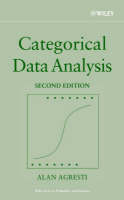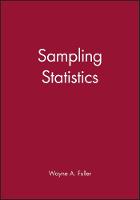Categorical Data Analysis
Categorical Data Analysis
Agresti, Alan
John Wiley and Sons Ltd
07/2002
734
Dura
Inglês
9780471360933
0471360937
1124
Responding to the developments in the field as well as to the needs of a new generation of professionals and students, this edition offers a comprehensive introduction to the most important methods for categorical data analysis. It is suitable for statisticians and biostatisticians as well as scientists and graduate students practicing statistics.
Preface. 1. Introduction: Distributions and Inference for Categorical Data. 1.1 Categorical Response Data. 1.2 Distributions for Categorical Data. 1.3 Statistical Inference for Categorical Data. 1.4 Statistical Inference for Binomial Parameters. 1.5 Statistical Inference for Multinomial Parameters. Notes. Problems. 2. Describing Contingency Tables. 2.1 Probability Structure for Contingency Tables. 2.2 Comparing Two Proportions. 2.3 Partial Association in Stratified 2 x 2 Tables. 2.4 Extensions for I x J Tables. Notes. Problems. 3. Inference for Contingency Tables. 3.1 Confidence Intervals for Association Parameters. 3.2 Testing Independence in Two Way Contingency Tables. 3.3 Following Up Chi Squared Tests. 3.4 Two Way Tables with Ordered Classifications. 3.5 Small Sample Tests of Independence. 3.6 Small Sample Confidence Intervals for 2 x 2 Tables . 3.7 Extensions for Multiway Tables and Nontabulated Responses. Notes. Problems. 4. Introduction to Generalized Linear Models. 4.1 Generalized Linear Model. 4.2 Generalized Linear Models for Binary Data. 4.3 Generalized Linear Models for Counts. 4.4 Moments and Likelihood for Generalized Linear Models . 4.5 Inference for Generalized Linear Models. 4.6 Fitting Generalized Linear Models. 4.7 Quasi likelihood and Generalized Linear Models . 4.8 Generalized Additive Models . Notes. Problems. 5. Logistic Regression. 5.1 Interpreting Parameters in Logistic Regression. 5.2 Inference for Logistic Regression. 5.3 Logit Models with Categorical Predictors. 5.4 Multiple Logistic Regression. 5.5 Fitting Logistic Regression Models. Notes. Problems. 6. Building and Applying Logistic Regression Models. 6.1 Strategies in Model Selection. 6.2 Logistic Regression Diagnostics. 6.3 Inference About Conditional Associations in 2 x 2 x K Tables. 6.4 Using Models to Improve Inferential Power. 6.5 Sample Size and Power Considerations . 6.6 Probit and Complementary Log Log Models . 6.7 Conditional Logistic Regression and Exact Distributions . Notes. Problems. 7. Logit Models for Multinomial Responses. 7.1 Nominal Responses: Baseline Category Logit Models. 7.2 Ordinal Responses: Cumulative Logit Models. 7.3 Ordinal Responses: Cumulative Link Models. 7.4 Alternative Models for Ordinal Responses . 7.5 Testing Conditional Independence in I x J x K Tables . 7.6 Discrete Choice Multinomial Logit Models . Notes. Problems. 8. Loglinear Models for Contingency Tables. 8.1 Loglinear Models for Two Way Tables. 8.2 Loglinear Models for Independence and Interaction in Three Way Tables. 8.3 Inference for Loglinear Models. 8.4 Loglinear Models for Higher Dimensions. 8.5 The Loglinear Logit Model Connection. 8.6 Loglinear Model Fitting: Likelihood Equations and Asymptotic Distributions . 8.7 Loglinear Model Fitting: Iterative Methods and their Application . Notes. Problems. 9. Building and Extending Loglinear/Logit Models. 9.1 Association Graphs and Collapsibility. 9.2 Model Selection and Comparison. 9.3 Diagnostics for Checking Models. 9.4 Modeling Ordinal Associations. 9.5 Association Models . 9.6 Association Models, Correlation Models, and Correspondence Analysis . 9.7 Poisson Regression for Rates. 9.8 Empty Cells and Sparseness in Modeling Contingency Tables. Notes. Problems. 10. Models for Matched Pairs. 10.1 Comparing Dependent Proportions. 10.2 Conditional Logistic Regression for Binary Matched Pairs. 10.3 Marginal Models for Square Contingency Tables. 10.4 Symmetry, Quasi symmetry, and Quasiindependence. 10.5 Measuring Agreement Between Observers. 10.6 Bradley Terry Model for Paired Preferences. 10.7 Marginal Models and Quasi symmetry Models for Matched Sets . Notes. Problems. 11. Analyzing Repeated Categorical Response Data. 11.1 Comparing Marginal Distributions: Multiple Responses. 11.2 Marginal Modeling: Maximum Likelihood Approach. 11.3 Marginal Modeling: Generalized Estimating Equations Approach. 11.4 Quasi likelihood and Its GEE Multivariate Extension: Details . 11.5 Markov Chains: Transitional Modeling. Notes. Problems. 12. Random Effects: Generalized Linear Mixed Models for Categorical Responses. 12.1 Random Effects Modeling of Clustered Categorical Data. 12.2 Binary Responses: Logistic Normal Model. 12.3 Examples of Random Effects Models for Binary Data. 12.4 Random Effects Models for Multinomial Data. 12.5 Multivariate Random Effects Models for Binary Data. 12.6 GLMM Fitting, Inference, and Prediction. Notes. Problems. 13. Other Mixture Models for Categorical Data . 13.1 Latent Class Models. 13.2 Nonparametric Random Effects Models. 13.3 Beta Binomial Models. 13.4 Negative Binomial Regression. 13.5 Poisson Regression with Random Effects. Notes. Problems. 14. Asymptotic Theory for Parametric Models. 14.1 Delta Method. 14.2 Asymptotic Distributions of Estimators of Model Parameters and Cell Probabilities. 14.3 Asymptotic Distributions of Residuals and Goodnessof Fit Statistics. 14.4 Asymptotic Distributions for Logit/Loglinear Models. Notes. Problems. 15. Alternative Estimation Theory for Parametric Models. 15.1 Weighted Least Squares for Categorical Data. 15.2 Bayesian Inference for Categorical Data. 15.3 Other Methods of Estimation. Notes. Problems. 16. Historical Tour of Categorical Data Analysis . 16.1 Pearson Yule Association Controversy. 16.2 R. A. Fisher s Contributions. 16.3 Logistic Regression. 16.4 Multiway Contingency Tables and Loglinear Models. 16.5 Recent and Future? Developments. Appendix A. Using Computer Software to Analyze Categorical Data. A.1 Software for Categorical Data Analysis. A.2 Examples of SAS Code by Chapter. Appendix B. Chi Squared Distribution Values. References. Examples Index. Author Index. Subject Index. Sections marked with an asterisk are less important for an overview.
Este título pertence ao(s) assunto(s) indicados(s). Para ver outros títulos clique no assunto desejado.
Responding to the developments in the field as well as to the needs of a new generation of professionals and students, this edition offers a comprehensive introduction to the most important methods for categorical data analysis. It is suitable for statisticians and biostatisticians as well as scientists and graduate students practicing statistics.
Preface. 1. Introduction: Distributions and Inference for Categorical Data. 1.1 Categorical Response Data. 1.2 Distributions for Categorical Data. 1.3 Statistical Inference for Categorical Data. 1.4 Statistical Inference for Binomial Parameters. 1.5 Statistical Inference for Multinomial Parameters. Notes. Problems. 2. Describing Contingency Tables. 2.1 Probability Structure for Contingency Tables. 2.2 Comparing Two Proportions. 2.3 Partial Association in Stratified 2 x 2 Tables. 2.4 Extensions for I x J Tables. Notes. Problems. 3. Inference for Contingency Tables. 3.1 Confidence Intervals for Association Parameters. 3.2 Testing Independence in Two Way Contingency Tables. 3.3 Following Up Chi Squared Tests. 3.4 Two Way Tables with Ordered Classifications. 3.5 Small Sample Tests of Independence. 3.6 Small Sample Confidence Intervals for 2 x 2 Tables . 3.7 Extensions for Multiway Tables and Nontabulated Responses. Notes. Problems. 4. Introduction to Generalized Linear Models. 4.1 Generalized Linear Model. 4.2 Generalized Linear Models for Binary Data. 4.3 Generalized Linear Models for Counts. 4.4 Moments and Likelihood for Generalized Linear Models . 4.5 Inference for Generalized Linear Models. 4.6 Fitting Generalized Linear Models. 4.7 Quasi likelihood and Generalized Linear Models . 4.8 Generalized Additive Models . Notes. Problems. 5. Logistic Regression. 5.1 Interpreting Parameters in Logistic Regression. 5.2 Inference for Logistic Regression. 5.3 Logit Models with Categorical Predictors. 5.4 Multiple Logistic Regression. 5.5 Fitting Logistic Regression Models. Notes. Problems. 6. Building and Applying Logistic Regression Models. 6.1 Strategies in Model Selection. 6.2 Logistic Regression Diagnostics. 6.3 Inference About Conditional Associations in 2 x 2 x K Tables. 6.4 Using Models to Improve Inferential Power. 6.5 Sample Size and Power Considerations . 6.6 Probit and Complementary Log Log Models . 6.7 Conditional Logistic Regression and Exact Distributions . Notes. Problems. 7. Logit Models for Multinomial Responses. 7.1 Nominal Responses: Baseline Category Logit Models. 7.2 Ordinal Responses: Cumulative Logit Models. 7.3 Ordinal Responses: Cumulative Link Models. 7.4 Alternative Models for Ordinal Responses . 7.5 Testing Conditional Independence in I x J x K Tables . 7.6 Discrete Choice Multinomial Logit Models . Notes. Problems. 8. Loglinear Models for Contingency Tables. 8.1 Loglinear Models for Two Way Tables. 8.2 Loglinear Models for Independence and Interaction in Three Way Tables. 8.3 Inference for Loglinear Models. 8.4 Loglinear Models for Higher Dimensions. 8.5 The Loglinear Logit Model Connection. 8.6 Loglinear Model Fitting: Likelihood Equations and Asymptotic Distributions . 8.7 Loglinear Model Fitting: Iterative Methods and their Application . Notes. Problems. 9. Building and Extending Loglinear/Logit Models. 9.1 Association Graphs and Collapsibility. 9.2 Model Selection and Comparison. 9.3 Diagnostics for Checking Models. 9.4 Modeling Ordinal Associations. 9.5 Association Models . 9.6 Association Models, Correlation Models, and Correspondence Analysis . 9.7 Poisson Regression for Rates. 9.8 Empty Cells and Sparseness in Modeling Contingency Tables. Notes. Problems. 10. Models for Matched Pairs. 10.1 Comparing Dependent Proportions. 10.2 Conditional Logistic Regression for Binary Matched Pairs. 10.3 Marginal Models for Square Contingency Tables. 10.4 Symmetry, Quasi symmetry, and Quasiindependence. 10.5 Measuring Agreement Between Observers. 10.6 Bradley Terry Model for Paired Preferences. 10.7 Marginal Models and Quasi symmetry Models for Matched Sets . Notes. Problems. 11. Analyzing Repeated Categorical Response Data. 11.1 Comparing Marginal Distributions: Multiple Responses. 11.2 Marginal Modeling: Maximum Likelihood Approach. 11.3 Marginal Modeling: Generalized Estimating Equations Approach. 11.4 Quasi likelihood and Its GEE Multivariate Extension: Details . 11.5 Markov Chains: Transitional Modeling. Notes. Problems. 12. Random Effects: Generalized Linear Mixed Models for Categorical Responses. 12.1 Random Effects Modeling of Clustered Categorical Data. 12.2 Binary Responses: Logistic Normal Model. 12.3 Examples of Random Effects Models for Binary Data. 12.4 Random Effects Models for Multinomial Data. 12.5 Multivariate Random Effects Models for Binary Data. 12.6 GLMM Fitting, Inference, and Prediction. Notes. Problems. 13. Other Mixture Models for Categorical Data . 13.1 Latent Class Models. 13.2 Nonparametric Random Effects Models. 13.3 Beta Binomial Models. 13.4 Negative Binomial Regression. 13.5 Poisson Regression with Random Effects. Notes. Problems. 14. Asymptotic Theory for Parametric Models. 14.1 Delta Method. 14.2 Asymptotic Distributions of Estimators of Model Parameters and Cell Probabilities. 14.3 Asymptotic Distributions of Residuals and Goodnessof Fit Statistics. 14.4 Asymptotic Distributions for Logit/Loglinear Models. Notes. Problems. 15. Alternative Estimation Theory for Parametric Models. 15.1 Weighted Least Squares for Categorical Data. 15.2 Bayesian Inference for Categorical Data. 15.3 Other Methods of Estimation. Notes. Problems. 16. Historical Tour of Categorical Data Analysis . 16.1 Pearson Yule Association Controversy. 16.2 R. A. Fisher s Contributions. 16.3 Logistic Regression. 16.4 Multiway Contingency Tables and Loglinear Models. 16.5 Recent and Future? Developments. Appendix A. Using Computer Software to Analyze Categorical Data. A.1 Software for Categorical Data Analysis. A.2 Examples of SAS Code by Chapter. Appendix B. Chi Squared Distribution Values. References. Examples Index. Author Index. Subject Index. Sections marked with an asterisk are less important for an overview.
Este título pertence ao(s) assunto(s) indicados(s). Para ver outros títulos clique no assunto desejado.












